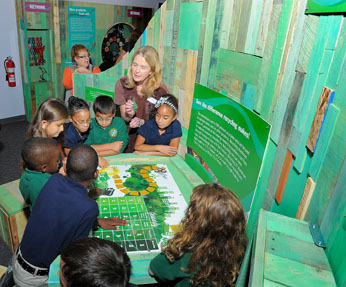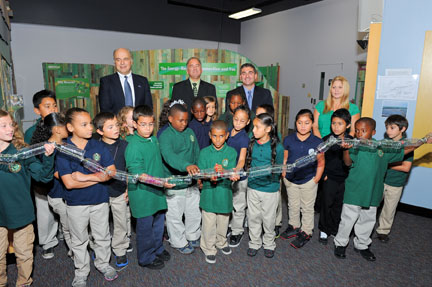|
CRRA Trash Museum
Starts Talking Energy Conservation
Partnership with Energize Connecticut
Shows how Recycling Saves Energy
HARTFORD, Conn. – Is there a connection between recycling and energy conservation?
A new exhibit at the Connecticut Resources Recovery Authority Trash Museum, unveiled at a grand-opening event today, not only answers that question with an emphatic “yes” but also explains how recycling reduces our country’s demand for energy.
CRRA partnered with the new Energize Connecticut initiative on the exhibit, which is entitled The Energy-Recycling Connection. The exhibit will feature interactive elements which focus on how the recycling process saves energy and money.
“Expanding Connecticut’s recycling efforts is a great way to help our environment and also to increase the number of green jobs in the state,” Energy Efficiency Board First Vice Chairman Jamie Howland said. “This new energy exhibit and interactive portal will help Connecticut residents better understand energy efficiency as it relates to recycling, as well as help convert their recycling efforts into energy and money savings.”
“Our education programs have taught more than 420,000 people that recycling reduces waste, conserves natural resources and benefits the environment,” said Thomas D. Kirk, CRRA president. “This partnership with Energize Connecticut will help CRRA show how the everyday decisions all of us make can mean big energy savings for our society.”
 |
Gina Alfieri (center), an educator at the Connecticut Resources Recovery Authority Trash Museum in Hartford, guides Grade 3 students from the Mary M. Hooker Environmental Sciences Magnet School in Hartford through a “Jeopardy!”-style board game that is part of a set of new energy-conservation exhibits that opened at the Trash Museum on Oct. 3. |
By following the exhibit’s curved walls, visitors navigate through five highlighted stations. At each station, built on frames made from re-purposed pallet wood, guests can interact with components of the exhibit area to further enhance their energy-recycling knowledge.
Beginning at the Reduce station, visitors calculate energy savings by stepping onto an industrial scale. That enables them to calculate how long a light bulb would stay lit just by recycling their weight in aluminum cans.
At the Re-think station, an interpretive display showcases unique products created from recycled materials and shows visitors artful ways to re-use materials. Here, consumers can re-think their everyday purchases by buying items made from recycled, re-used or upcycled products.
Within the Recycle section, visitors will see a model energy-efficient light bulb. On the side of the model bulb is a wheel a visitor can turn to reveal fun facts about recycling, natural resources and energy conservation. This eye-catching display will immediately draw visitors into the area to explore further.
The Recycle section also houses the CTRecycl-o-meter, a touchscreen panel allowing visitors to access a computer application that calculates the energy they can save just by recycling. Used at the Museum, in the classroom or as a follow-up lesson to the Museum programs, the CTRecycl-o-meter illustrates energy saving with engaging graphics and kid-friendly language.
Also in the Recycle section is the CTRecycl-o-matic, an interactive game that combines real-life footage of the recycling process with animation. Gamers sort recyclables with the same technology the processing center uses. The exhibit area will also feature a table with an encased “Jeopardy!”-style board game and cards with questions about recycling and energy conservation.
Lastly, the Recovery area will highlight the sustainable trash-to-energy process and how it recovers a vital resource—electricity—from waste.
The exhibits were unveiled this morning at a ceremony featuring the cutting of a ribbon of recycled water bottles made and held by students from Mary M. Hooker Environmental Sciences Magnet School in Hartford, who then became the first to use the interactive elements of the exhibit.
About Energize Connecticut
Energize Connecticut programs help you save money and use clean, affordable energy. The programs are a partnership of the Energy Efficiency Fund, the Clean Energy Finance & Investment Authority, and your local electric and gas utilities and are funded by a charge on customer energy bills.
Information on energy-saving programs can be found at EnergizeCT.com or by calling
1-877-WISE-USE.
About Connecticut Resources Recovery Authority
The Connecticut Resources Recovery Authority is a quasi-public agency whose mission is to work for – and in – the best interests of the municipalities of the state of Connecticut. CRRA’s board of directors and management team develop and implement environmentally sound solutions and best practices for solid waste disposal and recycling management on behalf of municipalities. CRRA serves 93 Connecticut cities and towns. CRRA also runs award-winning sustainability education programs through the CRRA Trash Museum in Hartford. For more information about CRRA and its activities, visit http://www.crra.org. Computer users can also discuss CRRA on its blog, and follow CRRA on Twitter at @CRRA.
About the CRRA Trash Museum
At the 6,500-square-foot Trash Museum, visitors can also watch CRRA’s state-of-the-art recycling center process bottles, cans, paper and cardboard, participate in a scavenger hunt at the Temple of Trash and see the exhibit featuring all the garbage Sustainable Dave made in a year. The Trash Museum is located at 211 Murphy Road in Hartford’s South Meadows. For more information, call 860-757-7765, visit the Trash Museum’s website or find the Trash Museum on Facebook.
 |
Third-graders from Hartford’s Mary M. Hooker Environmental Sciences Magnet School cut a ribbon they made from to open a new set of interactive exhibits called “The Energy-Recycling Connection” at the Connecticut Resources Recovery Authority Trash Museum in Hartford. Looking on are (standing, from left) Thomas D. Kirk, president, CRRA; Ron Araujo, manager, Energy-Efficiency Programs-Connecticut, Northeast Utilities; Chris Ehlert, manager, Residential Energy Services, The United Illuminating Company; and Stephanie Kuckel, Grade 3 teacher, Environmental Sciences Magnet School. The exhibits were created with a grant from Energize Connecticut, a partnership of the Connecticut Energy Efficiency Fund, the Clean Energy Finance & Investment Authority, and the state’s electric and gas utilities. |
—30—
|

